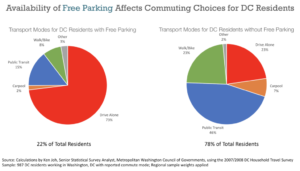CSG Testimony FY20 Budget Hearing for DHCD
Testimony before the Hon. Anita Bonds, Chair, Committee on Housing & Neighborhood Revitalization, Council of the District of Columbia
RE: FY2020 Budget Oversight Hearing for the Department of Housing and Community Development and Housing Production Trust Fund
By Cheryl Cort, Policy Director
April 23, 2019
Good afternoon, my name is Cheryl Cort and I am the policy director of the Coalition for Smarter Growth (CSG). The Coalition for Smarter Growth is the leading organization working locally in the Washington, D.C. metropolitan region dedicated to making the case for smart growth. Our mission is to promote walkable, inclusive, and transit-oriented communities, and the land use and transportation policies and investments needed to make those communities flourish.
We want to commend the Mayor for proposing a substantial increase to the Housing Production Trust Fund to $130 million and an increase in the Affordable Housing Preservation Fund to $15 million. D.C. continues to lead the country in its commitment to local funding for affordable housing, along with its use of important policy tools like TOPA and DOPA, and the administration’s innovations in the New Communities Initiative. These investments, policies, and programs are critical, but much more is needed to preserve and build affordable housing in a city that is rapidly becoming unaffordable to its low-paid workforce and many long-time residents.
The District continues to experience strong demand to live here, which drives up housing prices. In addition, the city’s economy has a large and growing gap between wages earned at white-collar jobs and the earnings of workers who provide essential services to many of the businesses upon which the high-paid professionals rely for day to day needs. To address the needs of low income residents, including the workers who fill 8 of the top 20 occupations in the city, we need deeper and more strategic investments. And we need stronger policies. The FY2020 budget can be more a part of the solution.
Workforce housing – make strategic investments for low wage workers to live in the city
We appreciate the administration’s attention to the housing needs of D.C.’s workforce. Helping workers live near their work has many family, community and environmental benefits. We are disappointed, however, that the income targeting proposed for the new $20 million “workforce” housing program, from 60% to 120% AMI, will miss providing assistance to the working households who most need it to stay in the city. The need starts at 50% AMI, and goes down from there.
Last month, we released a study on D.C.’s workforce housing needs (see attachment). We found:
- 8 of the most common 20 occupations pay less than $48,000 a year (e.g. administrative assistants);
- 5 of the top 20 jobs pay below $30,000 per year, which is considered extremely low income for a two-person household (e.g. janitors and cleaners);
- Not a single one of the most common 20 occupations in the District was between 50% and 80% AMI.
Many of the fastest growing service jobs in the District, such as home health aides, food preparation, and waiters/waitresses, earn extremely low incomes. At these income levels, most working households face severe housing cost burdens, paying more than half of their income to housing. In contrast, rarely does a household earning 80% AMI or more face severe housing cost burdens.
These data show that the District’s critical workforce housing needs are with those earning well below 80% AMI, let alone 120% AMI. But the income targeting for the Mayor’s workforce housing fund would target assistance for earners at 60% to 120% AMI, or $112,500 per year for a 2-person household. For higher earners at this range, we should focus on policies that make the housing market work better, to produce more moderately-priced homes in more neighborhoods. For the expenditure of scarce funds, we must be strategic. Based on our research, we recommend the follow to address affordable workforce housing needs:
- Establish a workforce housing policy for income targeting based on need using earnings data and severe cost burdens. We ask the Council to approve funding for the new workforce housing program using income targeting no higher than 60% AMI for rental and 80% AMI for ownership. In fact, based on our research, we recommend that the focus for workforce housing go to rental assistance at 30% and 50% AMI.
- Recommit the city (especially through DHCD and Office of Planning) to its obligation to comply with the Fair Housing Act’s Affirmatively Furthering Fair Housing rule. The D.C. Council can address this in part through the Comprehensive Plan update bill. The Comprehensive Plan should be revised to unlock the potential for less costly, mixed-income housing throughout the city. This is an important way to better address workforce housing needs up the income scale. The Comprehensive Plan should significantly expand the potential for creating new housing, including inclusionary zoning units, especially in high opportunity neighborhoods. The Comprehensive Plan must also ease restrictions on building housing, especially affordable and public housing, like the Park Morton/Bruce Monroe plan to replace deteriorated public housing.
- Greatly expand the Local Rent Supplement Program (LRSP) to provide rental assistance to help low-paid workers, especially through tenant-based LRSP. The FY20 budget proposes modest increased support for targeted affordable housing and project-based rental assistance. However, the budget proposed no additional tenant-based rental assistance. We urge the Council to add funding to tenant-based LRSP. In the long term, we should greatly expand LRSP and pair it with our fair housing efforts to bring more deeply affordable housing to high opportunity neighborhoods. These actions are a key way to address our workforce housing needs, and breakdown a legacy of discrimination which cuts off access to opportunity and choice.
Thank you for your consideration.
_________________________________
Attachment: Making Workforce Housing Work, a new report by Coalition for Smarter Growth, March 2019


